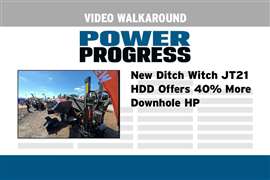Read this article in Français Deutsch Italiano Português Español
This is how Somero employs VR for operator training
05 March 2025
OEM worked with ForgeFX to develop laser screed training simulator.
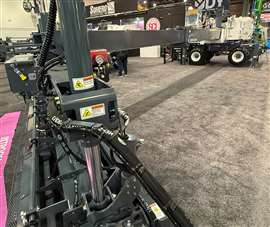 Somero’s S-22EZ Advanced Laser Screed on the company’s stand during the 2025 World of Concrete trade show in Las Vegas. (Photo: Chad Elmore)
Somero’s S-22EZ Advanced Laser Screed on the company’s stand during the 2025 World of Concrete trade show in Las Vegas. (Photo: Chad Elmore)
The flagship in Somero’s concrete finishing machine lineup has a 20-ft. telescoping boom, 360-degree machine rotation and laser-guided controls. The company said its S-22EZ Advanced Laser Screed is popular on large-scale flooring projects such as during the construction of warehouses because it can spread, level and vibrate concrete in a single pass. The machine helps crews finish thousands of square feet of concrete every day.
Mastering such a sophisticated piece of equipment can be a daunting task for a new operator, and that situation is made worse by the ongoing labor shortage in construction and other trades. According to the Associated General Contractors of America (AGC), last year 79% of construction firms reported difficulty in finding skilled workers, which impacted project timelines and cost – and prevented them from bidding on jobs.
“In today’s labor market, one of the biggest risks for our customers is finding someone willing to show up every day, learn the craft and do the job at a high skill level,” said Dave Raasakka, senior vice president, Global Customer Support, Somero Enterprises Inc., Fort Myers, Fla.
Concrete leveling depends on skill and craftsmanship. Errors can lead to costly rework, wasted material and time.
“There is a lot happening on a typical jobsite when an S22 is being used,” said Raasakka. “You’ve got the machine itself plus concrete mixers lined up full of product and you have people working on the floor. It’s a high-stakes process, and concrete is a high-stakes product. It’s perishable. Once it’s poured out, every second and every action matters.”
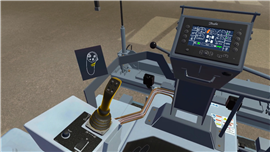 The view from the virtual cockpit of Somero’s laser screed training simulator. (Illustration: ForgeFX)
The view from the virtual cockpit of Somero’s laser screed training simulator. (Illustration: ForgeFX)
Transforming training
To address some of the challenges its customers were facing, Somero worked with San Francisco-based ForgeFX Simulations to develop the S-22EZ Advanced Laser Screed Virtual Training Simulator, which allows end users to learn the machine risk-free.
The OEM met the ForgeFX team at a World of Concrete show several years ago. Visitors to Somero’s booth during the 2024 event saw an early version of the results of that meeting. This year, Somero and ForgeFX introduced the finished product and called it a “paradigm shift” in operator training.
“Traditional training methods rely on learning in real-world scenarios, where mistakes can be costly, time consuming and hazardous,” said Greg Meyers, CEO and co-founder of ForgeFX Simulations. “This simulator transforms the training process by offering a risk-free environment where operators can refine their skills, gain confidence and master the intricacies of concrete leveling. By reducing errors, improving training efficiency and prioritizing safety, this tool delivers significant value to both trainees and the industry as a whole.”
By practicing in virtual reality (VR), Somero said trainees develop critical skills and muscle memory while minimizing expensive mistakes and eliminating the cost of fuel and material. Long before arriving at a jobsite, they can use the simulator to practice avoiding over-pours, making quick adjustments under tight time constraints and handling the equipment – even how to back the machine off the trailer.
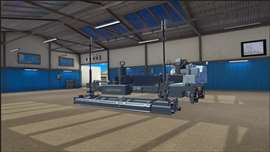 Somero said the training simulator will help end-users as well as its own technicians get up to speed quickly on its S-22EZ Advanced Laser Screed. (Illustration: ForgeFX)
Somero said the training simulator will help end-users as well as its own technicians get up to speed quickly on its S-22EZ Advanced Laser Screed. (Illustration: ForgeFX)
The virtual environment
ForgeFX’s team converted Somero’s CAD files for the screed into the simulator, creating high-fidelity models that operate smoothly in its simulation engine.
Trainees begin with pre-start inspections and cockpit familiarization, then progress to complex tasks such as screed head calibration and laser system setup. Tutorials, visual overlays and voice prompts guide trainees through the steps.
Designed for use on the commercially available Meta Quest VR headset, the simulator leverages Meta’s hand-tracking capability to ensure screeding operations and boom adjustments mirror real-world dynamics.
“Back when we started developing simulators, if I wanted an immersive simulator that had hand tracking and positional tracking and all the features that this system has, we would have had to build a dome the size of a room and equip it with a lot of projectors,” said Meyers. “Now we can get all of that in a $300 device you can buy at Best Buy. It’s a very mobile form factor, too, so if Dave [Raasakka] needs to ship a simulator, he can have it sent overnight.”
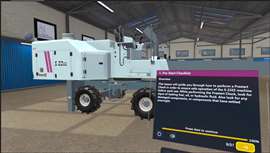 A screenshot from the training simulator ForgeFX Simulations created for Somero Enterprises’ flagship product, the S-22EZ Advanced Laser Screed. (Illustration: ForgeFX)
A screenshot from the training simulator ForgeFX Simulations created for Somero Enterprises’ flagship product, the S-22EZ Advanced Laser Screed. (Illustration: ForgeFX)
The simulator software is based on Unity XR tools and the ForgeSIM simulation engine to enable realistic physics, equipment modeling and dynamic feedback systems. Long the platform creator of choice for video game developers, Unity recently announced that Toyota Motor Co. selected it to develop the graphical user interface for its next-generation in-car human machine interface (HMI).
“We use simulation-based training tools to combine the knowledge from Dave’s team and his subject matter experts to incorporate them into our simulator,” said Meyer. “Being in the business of developing simulators for 20 years, we have a lot of code that we can reuse across all of our customers. Then we harness the Unity Interaction Toolkit [XRITK], which is basically a set of component-based tools. What this allows us to do is create a digital replica of Somero equipment and also create virtual concrete that has the right viscosity.”
Additional features of Somero’s training simulator include multi-user support and cloud-based performance tracking. Operators can run the simulator on their own in unguided/guided mode or in a trainer-led virtual environment. For example, Somero can use it to train operators in Boston and Barcelona on the same day without leaving the office.
Real-time feedback helps users understand the impact of their actions. Warnings sound for unsafe actions, such as extending the boom more than halfway without deploying stabilizers, which could cause the machine to tip.
Raasakka said the virtual training simulator will also be a valuable tool for Somero’s own employees. “We’re using the simulator to help build familiarity and reinforce terminology, so when customers call us for help then we’re all talking the same language. That’s very helpful just from a communication standpoint. From the Somero side, we have a very large group of technicians, and they travel all over the world to take care of our customers. If you start as a junior level technician or a trainer, it takes years to attain those skills.”
The simulator will be used at the Somero Concrete Institute in Fort Myers and will be sold worldwide through Somero for end-users and vocational programs.
This article originally appeared in the March 2025 issue of Power Progress.
POWER SOURCING GUIDE
The trusted reference and buyer’s guide for 83 years
The original “desktop search engine,” guiding nearly 10,000 users in more than 90 countries it is the primary reference for specifications and details on all the components that go into engine systems.
Visit Now
STAY CONNECTED




Receive the information you need when you need it through our world-leading magazines, newsletters and daily briefings.
CONNECT WITH THE TEAM













